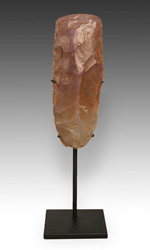 |
| Necklace composed of excavated etched agate beads from the Bronze Age; PRIMITIVE ID# J0506-034 |
-->
Edited by Glen Joffe
| |
 |
| |
For 'The Digger,' discovering something in the ground was a pure delight |
They called him The Digger, Diggy for short. It was an apt nickname considering his peculiar hobby – digging. As a child he dug countless craters in his parent’s garden and didn’t stop until he had pock-marked the lawns of all his relatives. As an adult, friends couldn’t invite him to their homes lest he sneak into their backyards, regardless of the season, with a tiny shovel in his hands and a delighted gleam in his eyes. He loved the feel of dirt in his hands and the prospect of discovery as he tilled the earth. Whenever he discovered something in the ground, whether it was a nondescript pebble, a disgruntled insect or a man-made item buried and forgotten in time, he felt profound pleasure. His insatiable desire to dig in all sorts of places drove him to develop real estate just so he could buy raw land, dig to his heart’s content and then move on to new projects.
 |
|
Fossilized Jawbone with four teeth; PRIMITIVE ID# A1000-243
|
|
His friends all asked the same question, “Why do you like digging so much?” His answer was simple, “The Earth is one big treasure chest. You never know what secret you’ll come across that the Earth has been hiding for years.” Next, his friends would inevitably ask, “What have you found?” His reply was equally predictable; “All sorts of wonderful things.” Indeed, those who visited his home found rooms packed with excavated objects such as vintage coins, metal shards, unusual stones, and even golden nuggets. Showcased beside these finds were objects that had been gifted to him by archaeological teams and museums he had sponsored from all over the globe. There were Stone Age knapped blades, fossils of all sorts and varieties, pottery, beads and oxidized metal sculptures.
| |
 |
 |
| |
Framed Knapped Blade Collection excavated in the Sahara Desert, North Africa; PRIMITIVE ID# A1100-313 |
The Digger found joy and passion in discovering items buried in the ground for years. Objects cradled in Earth’s warm embrace laying undisturbed for centuries attained unique patinas impossible to artificially recreate. One of his favorite finds were fossils, which he considered works of art taking millions of years to complete. The preservation of micro details from the original shell or skeleton was something no mortal artist could achieve. He would become lost in examining these details and imagining what conditions were like so many millennia ago. Unlike other types of excavated objects, fossils were once alive.
 |
|
Prehistoric Knapped Blade excavated in the Sahara Desert, Africa; PRIMITIVE ID# A1000-243
|
|
Collections of knapped blades adorned the walls of the Digger’s expansive library and study, reflecting his enthusiasm for mankind’s early evolution and ingenuity. Those that weren’t framed were gracefully based. He particularly enjoyed running his fingers over the sharpened knapped edges. He imagined the people who made these objects steadfastly sculpting them for the sake of survival. Never in their wildest dreams would they have guessed that millions of years later their descendants would discover these tools and piece together the history and evolution of mankind. It must have been impossible for them to imagine collectors and enthusiasts perceiving these tools as art and placing great value on them.
| |
 |
| |
Necklace composed of excavated Ancient Islamic glass; PRIMITIVE ID# J0309-152 |
There was an intangible quality the Digger found irresistible about excavated objects. In his eyes the earth transformed each and every item in a singular way. For example, he had an extensive collection of glass beads, worn smooth and stripped of all sheen and luster. Metal objects, such as Middle Eastern blades or African artifacts had likewise lost their bronze shine to be replaced by a darker, bluish tint. These changes were far from diminishing. In fact, the Digger knew the beauty of their patinas emanated from within. It was the type of beauty that was felt as much as seen.
Who knows what secret the Earth will reveal next? It may be an ancient piece of evidence that would turn historical theories upside down or perhaps a collection of medieval jewelry buried underground and lost for centuries. Whatever these objects may be, they will undoubtedly offer invaluable connections to the past as well as meaningful and beautiful artworks touched by the Earth.
 |
| Necklace composed of excavated etched agate beads from the Bronze Age; PRIMITIVE ID# J0506-034 |









